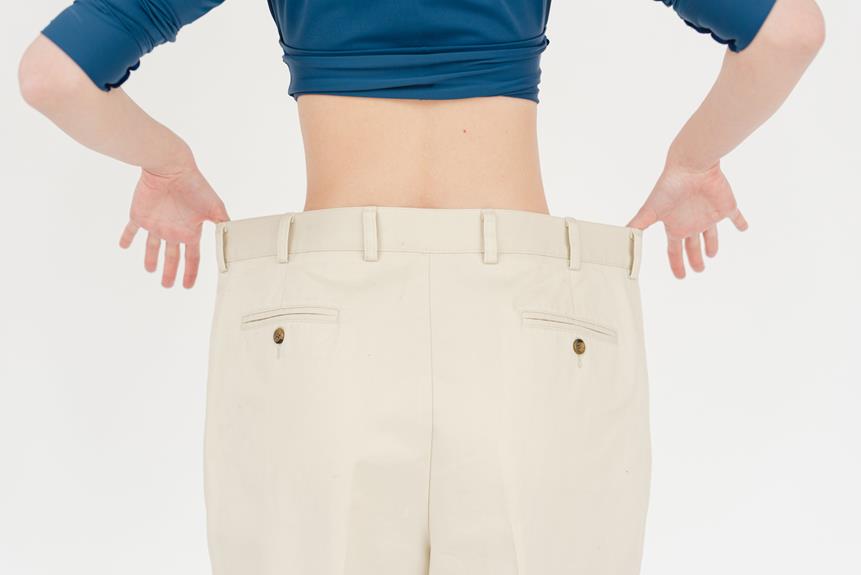When it comes to measuring your waist size on pants, mastering the art of precision is key. Whether you're shopping for new trousers or ensuring the perfect fit, having a clear understanding of the various methods can make all the difference.
From the traditional waist measurement to the hip-to-waist ratio, there are 7 simple techniques to help you achieve accurate results. Each method offers its own unique approach, allowing you to tailor your measurement process to your specific needs.
Let's explore these straightforward and effective ways to measure your waist size on pants, providing you with the mastery you desire.
Key Takeaways
- Traditional waist measurement using a flexible measuring tape is a common method for measuring waist size on pants.
- Waistband elasticity is important for comfort and support, and finding the right balance is crucial.
- Measuring the waistband accurately and comparing the measurements can help in assessing the fit of pants.
- DIY waistband extension techniques can be used to make pants more comfortable without buying new ones.
Traditional Waist Measurement
To measure the traditional waist size on pants, you should use a flexible measuring tape and wrap it around your waist at the level of your navel. Ensure that the measuring tape is parallel to the ground and snug against your skin, but not too tight. Take the measurement at the end of a normal breath to ensure accuracy.
Once you have the measurement, it's crucial to compare it to the sizing chart of the brand or store where you're purchasing the pants. In some cases, the waist size may not correspond directly to the measurement due to variations in sizing standards.
Understanding the traditional waist measurement method is essential for achieving a well-fitting garment, especially if you're considering making clothing alterations. By mastering this technique, you can confidently select the right size and make informed decisions regarding any necessary adjustments to your pants for a personalized fit.
Hip-to-Waist Ratio
Wrapping the measuring tape around your hips while standing with your feet together, you can calculate the hip-to-waist ratio to gain insights into your body's proportions and overall health. This ratio is an essential measurement for understanding your body shape and can provide valuable information about potential health risks.
To measure your hip-to-waist ratio, first, measure your waist at the narrowest point, typically just above the belly button. Then, measure your hips at the widest point, usually across the buttocks. Once you have these measurements, divide your waist measurement by your hip measurement. A ratio of 0.85 or lower is generally considered healthier, as it indicates a smaller waist in relation to the hips.
Understanding your hip-to-waist ratio is beneficial for assessing clothing fit and body proportions. It can help you choose clothing that flatters your figure and supports a healthy lifestyle. Monitoring changes in your hip-to-waist ratio over time can also provide insights into potential shifts in your body composition and overall health.
String or Ribbon Method
Measure your waist size on pants using the string or ribbon method for a simple and accurate way to determine your clothing size. Here's how to do it:
- Gather Materials: Find a flexible string or ribbon, ensuring it's long enough to wrap around your waist and tie comfortably.
- Wrap Around Waist: Stand in front of a mirror and wrap the string or ribbon around the narrowest part of your waist, just above your belly button. Ensure it's parallel to the ground.
- Mark or Cut: Once the string is comfortably wrapped around your waist, mark or cut the string at the point where the end meets the rest of the string.
- Measure the Length: Lay the marked or cut string flat and measure it using a ruler or tape measure. This measurement is your waist size.
The string or ribbon method is a popular technique used in tailoring and fashion trends to ensure a precise fit. By following this method, you can accurately measure your waist size on pants and use this information to make informed clothing choices.
Pant Size Conversion Chart
Wondering why your usual size doesn't fit when shopping for pants abroad?
The Pant Size Conversion Chart can help you understand international size differences and find the right fit.
Understanding how different countries measure and label pant sizes can save you from the frustration of trying on multiple sizes before finding the perfect pair.
International Size Differences Explained
To ensure a proper fit when shopping for pants internationally, refer to the pant size conversion chart for accurate waist measurements. Understanding international size differences is crucial, as sizing standards and fit variations can vary significantly from one country to another.
Here's a brief overview of international size differences explained:
- European Sizes: European sizes tend to run smaller than American sizes. For example, a size 8 in the US is equivalent to a size 40 in Europe.
- UK Sizes: UK sizes are similar to European sizes but may have slight variations. A UK size 12 is typically equivalent to a size 42 in Europe.
- Asian Sizes: Asian sizes are generally smaller than both US and European sizes. It's important to carefully check the measurements and refer to the conversion chart for accuracy.
- Australian Sizes: Australian sizes are usually close to UK sizes, but it's still essential to refer to the conversion chart for precise measurements.
Finding the Right Fit
When shopping for pants internationally, refer to the pant size conversion chart to ensure you find the right fit for your waist measurements. Fit assessment is crucial when determining the size compatibility of pants from different regions.
Take accurate waist measurements and then consult the conversion chart to find the corresponding size in the desired international standard. Keep in mind that different countries may have variations in their sizing systems, so relying on the conversion chart is essential for achieving the right fit.
Understanding the nuances of pant size conversions will help you make informed decisions when purchasing pants from global retailers. By using the pant size conversion chart as a guide, you can confidently select the right size and ensure that the pants fit comfortably around your waist.
Waistband Comparison
When comparing waistbands, it's essential to consider the elasticity of the material.
Start by measuring across the waistband to get an accurate idea of the size.
This will help you assess the comfort fit of the pants and determine the best option for your needs.
Waistband Elasticity Importance
When comparing waistband elasticity, there are several factors to consider. Firstly, you can measure stretch by pulling gently around the waistband and assessing the give. This initial stretch will give you an idea of how flexible the waistband is.
The importance of waistband elasticity lies in its ability to provide comfort and flexibility. A waistband that has good elasticity will move with your body and allow for easy movement. However, it's important to note that waistband elasticity also has its limitations. Over time, the waistband may stretch out and lose some of its elasticity.
Here's what to consider when comparing waistband elasticity. Firstly, notice how much the waistband stretches when gently pulled. This will give you an idea of the initial flexibility of the waistband. Secondly, observe how quickly the waistband returns to its original shape after stretching. A waistband that quickly recovers its shape is generally more durable.
Durability is an important factor to consider when it comes to waistband elasticity. Think about the long-term effects of stretching on the waistband's elasticity. A waistband that stretches out easily may not be as durable in the long run.
Lastly, it's important to balance the comfort of a flexible waistband with the support needed to keep pants in place. While a highly flexible waistband may be comfortable, it may not provide enough support to keep your pants in place.
Understanding the importance of waistband elasticity can help you choose pants that offer the right balance of comfort and durability. By considering factors like initial stretch, recovery time, durability, and comfort vs. support, you can make an informed decision when comparing waistband elasticity.
Measuring Across Waistband
To measure across the waistband for comparison, simply place the measuring tape at the top of the waistband and pull it straight across to the opposite side. When comparing waistband sizes, it's essential to consider the waistband stretching and construction. The table below provides a clear comparison of waistband measurements from different pants, allowing you to assess the variations in waistband sizes and construction.
| Pants Style | Waistband Measurement (inches) | Waistband Stretching | Waistband Construction |
|---|---|---|---|
| Jeans | 32 | Low | Button and Zipper |
| Dress Pants | 34 | Medium | Hook and Eye Closure |
| Yoga Pants | 30 | High | Elastic Waistband |
Comfort Fit Assessment
To assess the comfort fit of pants, measure the waistband and compare the results to determine the most suitable size for your body. This will help in comfort fit evaluation and sizing accuracy.
Follow these steps to ensure the perfect fit:
- Measure the Waistband: Use a flexible measuring tape to measure the waistband of the pants, ensuring it lies flat and isn't stretched.
- Compare Measurements: Compare the waistband measurement with your actual waist size to identify any discrepancies.
- Assess Comfort: Put on the pants and assess the comfort level of the waistband. Ensure it's neither too tight nor too loose.
- Make Fit Adjustments: If necessary, consider alterations or try a different size to achieve the ideal waistband comfort.
Body Measurement Tape
Use a flexible body measurement tape to accurately measure your waist size when determining pant size.
When it comes to clothing size accuracy and correct fit assessment, using a body measurement tape is crucial for obtaining precise measurements. To measure your waist, wrap the tape around the narrowest part of your torso, typically just above the belly button. Ensure the tape is parallel to the floor and snug against your skin, but not so tight that it compresses the skin.
Take the measurement without holding your breath or sucking in your stomach, as this can result in an inaccurate measurement. Once you have the measurement, refer to the sizing chart provided by the clothing manufacturer to determine the appropriate pant size. Remember that pant sizes can vary between brands, so it's essential to take accurate measurements each time you purchase new pants.
DIY Waistband Extension
You can easily create a DIY waistband extension using a few common household items. When your pants feel a bit snug around the waist, there's no need to replace them. Try these waistband extension options and DIY alteration techniques to make your pants fit comfortably again:
- Fabric Insert: Cut a piece of fabric to match the width of your waistband and sew it to the inside of the waistband to add extra room.
- Button Extender: Sew a button to one end of an elastic band and a buttonhole to the other end. Attach the button extender to your pants for an adjustable waistband.
- Hook and Eye Closure: Sew a hook and eye closure to the inside of the waistband, allowing you to expand the waistband by hooking it to a different eye.
- Denim Gusset: Use denim fabric to create a gusset by cutting a triangular piece and sewing it into the waistband's sides to provide extra width.
With these simple DIY alteration techniques, you can extend the waistband of your pants to achieve a more comfortable fit without having to buy new ones.
Frequently Asked Questions
What Are the Potential Health Risks Associated With Having a Larger Waist Size?
Having a larger waist size can lead to obesity consequences and health implications. It increases the risk of heart disease, type 2 diabetes, and stroke. It's important to manage your waist size for overall health and well-being.
How Often Should I Measure My Waist to Track Changes in Size?
You should measure your waist size every 2-4 weeks to track changes. Regular measurements can help monitor progress toward weight loss and fitness goals. Consistent tracking provides valuable data for adjusting your fitness routine.
Are There Any Specific Types of Pants or Waistbands That Are Better for Measuring Waist Size Accurately?
When measuring waist size, different materials, elastic waistbands, and tailored pants can affect accuracy. Consider body shape and fitting styles for precise measurements. Elastic waistbands and stretchy materials can provide a more accurate fit.
Can Waist Size Measurements Be Affected by Factors Such as Bloating or Weight Fluctuations?
Bloating can influence waist size measurements, causing temporary changes. Weight fluctuations impact measurements as well, affecting accuracy. To ensure precise results, it's important to consider these factors and measure your waist at consistent times.
Are There Any Alternative Methods for Measuring Waist Size That May Be More Accurate for Certain Body Types?
For different body types, custom tailoring can provide accurate waist measurements. This method ensures a precise fit, especially for those with unique proportions. Consider custom tailoring as an alternative for accurate waist sizing.
- How to Tell if Fabric Is Woven or Nonwoven - July 10, 2025
- The Complete Guide to Nonwoven Materials - July 10, 2025
- What Is a Nonwoven Textile? a Broad Definition - July 9, 2025





